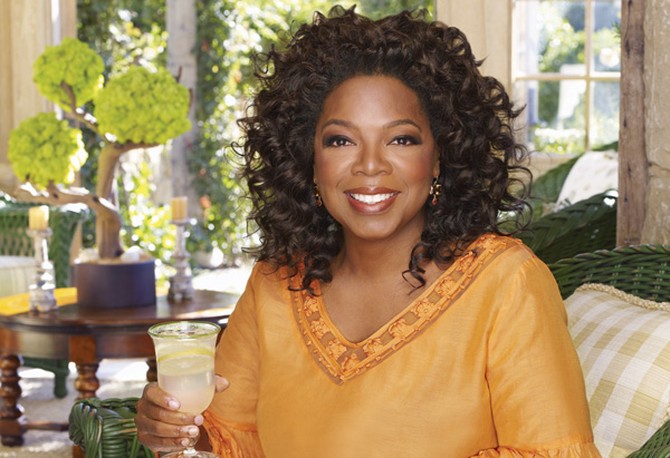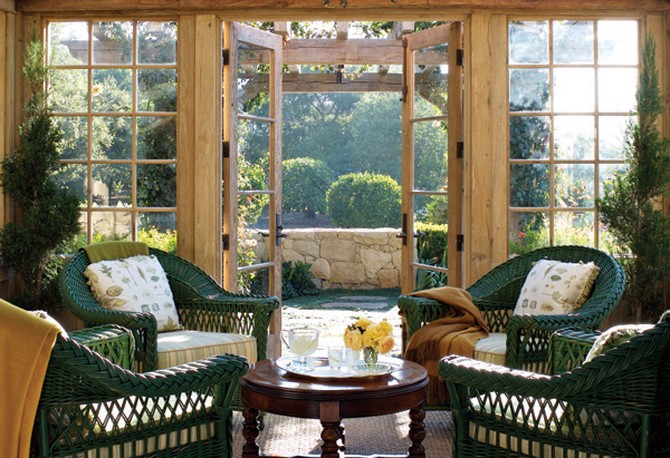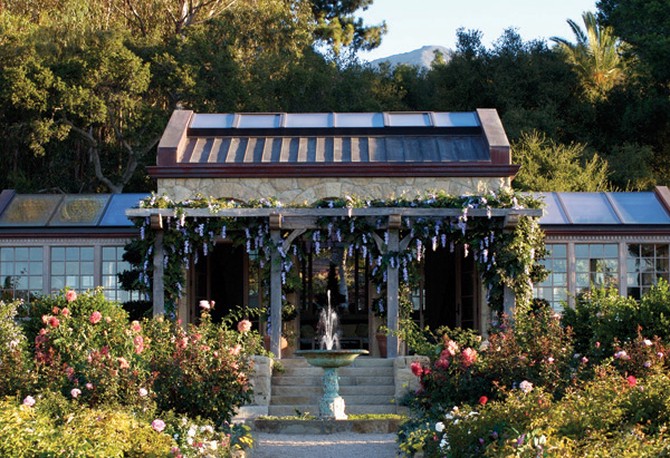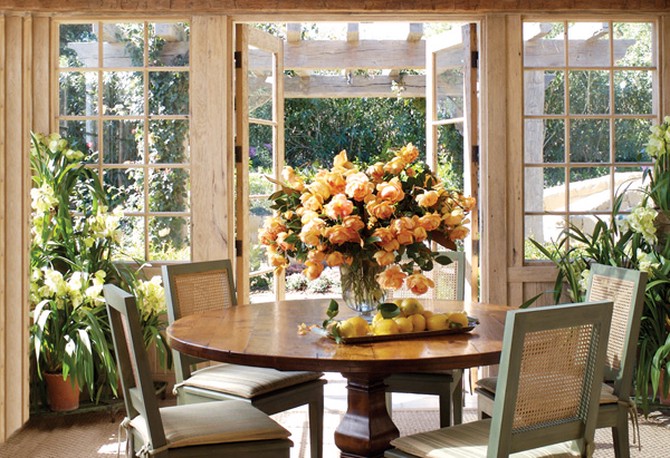Oprah's Teahouse
Surrounded by rosebushes, hydrangeas and dahlias, Oprah's teahouse is the one place she can go to get away from it all.

Oprah sits on a sofa in her teahouse facing the view—not any view, but the view, the reason she bought her Montecito, California, home and built the teahouse in this spot.
Through an arched door framed by wisteria, stairs lead down to a long gravel path bordered on both sides by roses. An elegant copper fountain sits right in the center. Beyond, the path seems to vanish into ocean and islands.
Oprah's attention, however, is not on the view but on the very near distance. On grout. Yes, the grout on the stone floor.
"I chose the color of the grout," she says, "and I chose the particular kind of gravel that was right for the rose garden, and another kind for the pathways. Grout color and gravel size would drive most people nuts. But it's all part of the process for me."
Through an arched door framed by wisteria, stairs lead down to a long gravel path bordered on both sides by roses. An elegant copper fountain sits right in the center. Beyond, the path seems to vanish into ocean and islands.
Oprah's attention, however, is not on the view but on the very near distance. On grout. Yes, the grout on the stone floor.
"I chose the color of the grout," she says, "and I chose the particular kind of gravel that was right for the rose garden, and another kind for the pathways. Grout color and gravel size would drive most people nuts. But it's all part of the process for me."

Five years ago, when Oprah first envisioned this small building, she planned it as a cutting room for flowers. But as she watched the structure take shape, she thought, "I'm going to want this space for myself." So rather than equip the room with utilitarian countertops and pruning shears, she and her interior designer, Ellie Cullman, filled it with comfortable furnishings—including a green wicker sofa and armchairs.
"This is mud from yesterday," Oprah says, pointing at paw marks left on the sofa by her white golden retrievers. "That's what you've got to live with," she adds, proving that she's looking at the long view, too.
"This is mud from yesterday," Oprah says, pointing at paw marks left on the sofa by her white golden retrievers. "That's what you've got to live with," she adds, proving that she's looking at the long view, too.

The teahouse is where Oprah comes to read, meditate, and enjoy a cup of tea. She could listen to music at the touch of a button but doesn't: "I don't want to affect the mood here."
She could transact business here, but doesn't: "No meetings, ever."
She may not visit for months at a time, only stopping by when she can really get away. "It's a commitment when I allow myself to come here," Oprah says. But whether she's in Montecito or Chicago or Johannesburg, the existence of the teahouse—just knowing it's there—is essential to her well-being. "It's my dream, having a place like this. Some people ask, 'Why do you need more space?' And I tell them, 'I need it to restore myself.'"
Immediately beyond that arched door and the surrounding clusters of purple flowers is her English garden, its varieties of perennials and annuals creating a natural, unplanned feeling. Oprah loves it, she says, "because of its diversity."
Below lies the splendor of her rose garden. Planted in parterres that slope down both sides of the central path, it's an acre designed by master rosarian Dan Bifano to ensure that there's always something in bloom. "I had my hands down in the dirt, helping plant these," Oprah says, as she walks through the garden to the orange and butter-yellow roses that contrast so beautifully with a large semicircle of lavender that marks the end of the teahouse garden.
She could transact business here, but doesn't: "No meetings, ever."
She may not visit for months at a time, only stopping by when she can really get away. "It's a commitment when I allow myself to come here," Oprah says. But whether she's in Montecito or Chicago or Johannesburg, the existence of the teahouse—just knowing it's there—is essential to her well-being. "It's my dream, having a place like this. Some people ask, 'Why do you need more space?' And I tell them, 'I need it to restore myself.'"
Immediately beyond that arched door and the surrounding clusters of purple flowers is her English garden, its varieties of perennials and annuals creating a natural, unplanned feeling. Oprah loves it, she says, "because of its diversity."
Below lies the splendor of her rose garden. Planted in parterres that slope down both sides of the central path, it's an acre designed by master rosarian Dan Bifano to ensure that there's always something in bloom. "I had my hands down in the dirt, helping plant these," Oprah says, as she walks through the garden to the orange and butter-yellow roses that contrast so beautifully with a large semicircle of lavender that marks the end of the teahouse garden.

Knowing Dan Bifano's reputation—he has designed a number of high-profile gardens, including several for Barbra Streisand—Oprah asked to meet him when she moved to Montecito.
After arriving with a bucketful of assorted roses to get a sense of Oprah's reaction to color, style, and texture, Dan created gardens that would complement the colors inside the main house. Then, he spent the next five years—with the help of hybridizer Tom Carruth—bringing an entirely new rose into being.
The Legends Rose, which will be available to the public beginning in December 2008, is one of the largest hybrid teas ever created. Oprah named the rose, which is red with black tips and ruffled petals (like "a Spanish dancer's dress," Bifano says) in honor of the 18 African-American women—the legends—she celebrated with a three-day festival in 2005. She has a photograph of these women hanging in her main house: giants of the arts like Maya Angelou, Tina Turner, and Ruby Dee, side by side with 36 "young'uns" like Janet Jackson, Mariah Carey, and Alicia Keys. "All the young'uns paid tribute to the elders," Oprah says. "I had a ball."
After arriving with a bucketful of assorted roses to get a sense of Oprah's reaction to color, style, and texture, Dan created gardens that would complement the colors inside the main house. Then, he spent the next five years—with the help of hybridizer Tom Carruth—bringing an entirely new rose into being.
The Legends Rose, which will be available to the public beginning in December 2008, is one of the largest hybrid teas ever created. Oprah named the rose, which is red with black tips and ruffled petals (like "a Spanish dancer's dress," Bifano says) in honor of the 18 African-American women—the legends—she celebrated with a three-day festival in 2005. She has a photograph of these women hanging in her main house: giants of the arts like Maya Angelou, Tina Turner, and Ruby Dee, side by side with 36 "young'uns" like Janet Jackson, Mariah Carey, and Alicia Keys. "All the young'uns paid tribute to the elders," Oprah says. "I had a ball."

As she continues along a cobblestone road that winds its way through her property, Oprah points out a path—Hallelujah Lane, she calls it—lined with thousands of white hydrangeas. She didn't have a garden when she was a child, she says. "All I had was the hydrangea bush that was in front of my grandmother's porch." Hallelujah Lane is a living, blooming homage to her grandmother. White-pink Sombreuil roses (above), which were developed in the 1880s, climb the wrought-iron arches, while the newer, pure-white Iceberg roses surround the statue.
"I can get excited over little things," Oprah says as she walks past a patch of artichokes and green peppers. "I see a basket of heirloom tomatoes from my garden, and it's so beautiful that I have to take a picture. Just the bounty of it, the fact that this just came out of the ground, the fact—oh, I can go on and on about the tomatoes until people say, 'Hey, it's a tomato!'"
In a grassy meadow near an avocado orchard, an enormous live oak tree holds center stage, its branches bending and twisting far out on all sides. It's Oprah's favorite tree. "At one point, I was advised to put some steel beams underneath to hold her arms up. I had the groundskeepers take them out because I thought she would be embarrassed."
She?
Oprah repeats, with emphasis, "She."
Would wooden supports have done better?
Oprah pauses. "Yes. But she doesn't want them. She'll stand as long as she can. When she's ready to go, she'll go."
As I returned to my home, I thought about grout, how it holds things together. To care about grout is to care about more than a tiny detail; it's an expression of making everything matter. For Oprah, everything is essential to her whole vision. "I love my home," she says. "My home is a gift."
Where Oprah Goes to Get Away from It All
Go inside Oprah's Hawaiian retreat
Tour Oprah's library in California
7 roses Oprah loves
"I can get excited over little things," Oprah says as she walks past a patch of artichokes and green peppers. "I see a basket of heirloom tomatoes from my garden, and it's so beautiful that I have to take a picture. Just the bounty of it, the fact that this just came out of the ground, the fact—oh, I can go on and on about the tomatoes until people say, 'Hey, it's a tomato!'"
In a grassy meadow near an avocado orchard, an enormous live oak tree holds center stage, its branches bending and twisting far out on all sides. It's Oprah's favorite tree. "At one point, I was advised to put some steel beams underneath to hold her arms up. I had the groundskeepers take them out because I thought she would be embarrassed."
She?
Oprah repeats, with emphasis, "She."
Would wooden supports have done better?
Oprah pauses. "Yes. But she doesn't want them. She'll stand as long as she can. When she's ready to go, she'll go."
As I returned to my home, I thought about grout, how it holds things together. To care about grout is to care about more than a tiny detail; it's an expression of making everything matter. For Oprah, everything is essential to her whole vision. "I love my home," she says. "My home is a gift."
Where Oprah Goes to Get Away from It All
Go inside Oprah's Hawaiian retreat
Tour Oprah's library in California
7 roses Oprah loves
From the Spring 2008 issue of O, The Oprah Magazine

